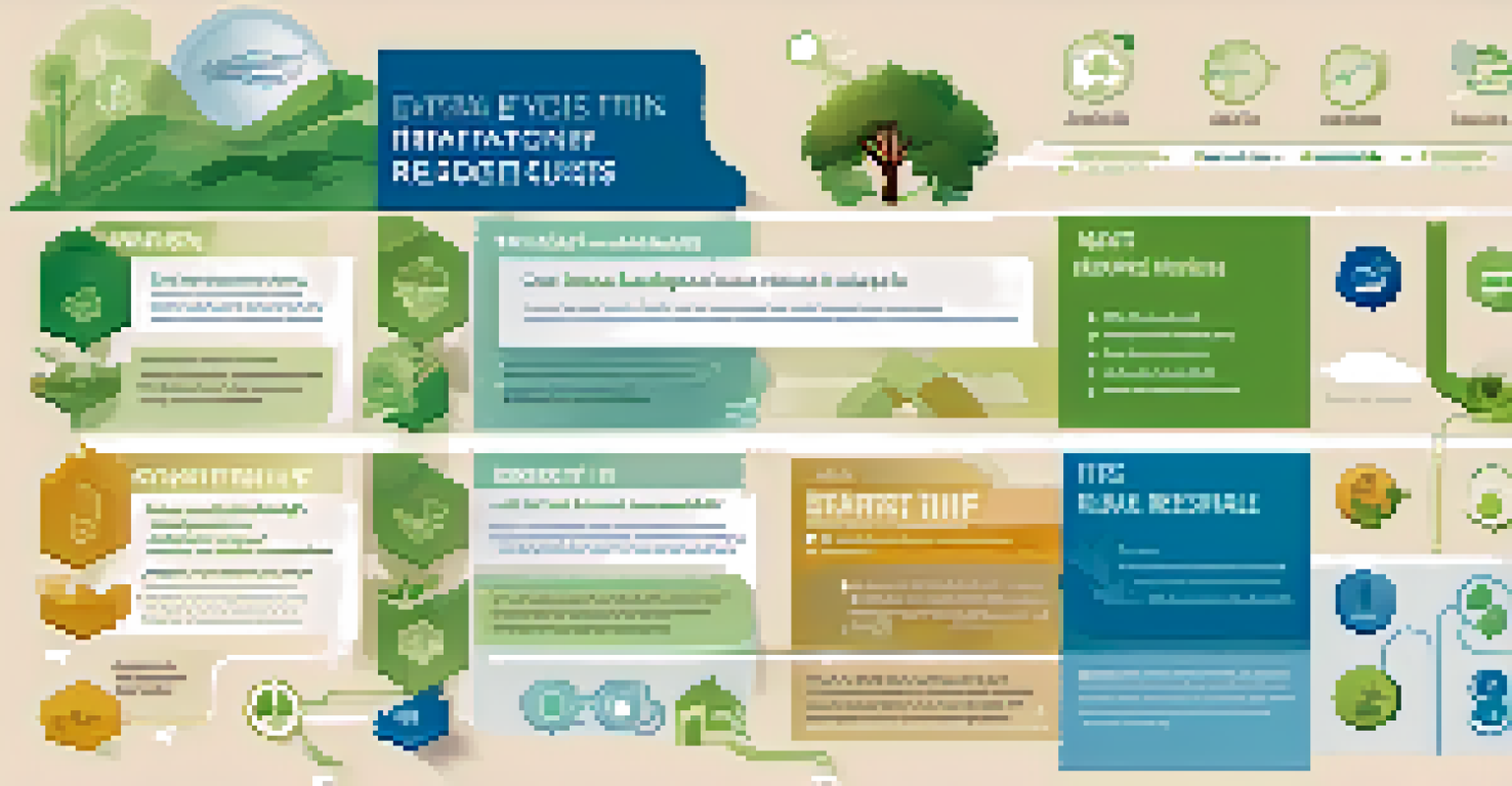Strategies to Reduce Carbon Footprint in Business

Understanding Your Carbon Footprint: The First Step
Before businesses can effectively reduce their carbon footprint, they need to understand what it is. A carbon footprint measures the total greenhouse gas emissions caused directly or indirectly by an organization. This includes everything from the energy consumed in office buildings to the emissions from shipping products.
The greatest threat to our planet is the belief that someone else will save it.
To get started, businesses can conduct a carbon audit. This involves tracking energy use, waste production, and transportation emissions over a set period. By identifying the largest contributors to their carbon footprint, companies can prioritize where to focus their reduction efforts.
An insightful first step is to engage employees in this process. Sharing findings and involving them in creating solutions fosters a culture of sustainability within the workplace.
Embracing Renewable Energy Sources
Switching to renewable energy sources is one of the most impactful strategies a business can adopt. Options such as solar, wind, or hydroelectric power not only reduce reliance on fossil fuels but can also lead to significant cost savings over time. Companies can either invest in renewable energy installations or purchase green energy from utility providers.

For example, a business that installs solar panels on its roof can generate its own electricity, lowering its energy costs while reducing carbon emissions. Plus, many governments offer incentives for businesses that make the switch to renewable energy, making it a financially savvy choice.
Understand Your Carbon Footprint
Before taking action, businesses should conduct a carbon audit to identify their main sources of greenhouse gas emissions.
Investing in renewable energy isn't just good for the planet; it also enhances a company’s reputation. Consumers increasingly prefer brands that demonstrate environmental responsibility, making sustainability a competitive advantage.
Implementing Energy Efficiency Measures
Energy efficiency is a key area where businesses can make a significant impact on their carbon footprint. Simple changes, like upgrading to energy-efficient lighting and equipment, can reduce energy consumption and costs. For instance, switching to LED bulbs can save businesses up to 75% on lighting costs.
We do not inherit the earth from our ancestors, we borrow it from our children.
Conducting an energy audit can help identify areas of improvement. This may involve assessing heating, ventilation, and air conditioning (HVAC) systems, as well as insulation and windows. By optimizing these systems, businesses can not only lower their carbon emissions but also improve employee comfort.
Moreover, adopting smart technology can further enhance efficiency. Smart thermostats and energy management systems allow businesses to monitor and control energy usage in real-time, preventing waste and maximizing savings.
Encouraging Sustainable Transportation Options
Transportation is a significant contributor to many businesses' carbon footprints. Encouraging employees to use public transportation, carpool, or bike to work can dramatically reduce emissions associated with commuting. Companies can incentivize these options through subsidies or rewards for those who choose eco-friendly travel methods.
Additionally, businesses can consider implementing remote work policies, which decrease the need for daily commuting altogether. By allowing employees to work from home, companies not only reduce their carbon footprint but also often see increased productivity and employee satisfaction.
Adopt Renewable Energy Solutions
Switching to renewable energy sources like solar or wind not only reduces emissions but can also lead to cost savings and enhanced brand reputation.
For logistics, opting for companies that utilize electric or hybrid vehicles can further minimize transportation emissions. This holistic approach to sustainable transportation can really pay off in terms of both environmental impact and employee morale.
Reducing Waste Through Recycling and Composting
Waste management is another critical area for reducing carbon emissions. By implementing recycling programs, businesses can divert a significant amount of waste from landfills, where it would otherwise produce methane, a potent greenhouse gas. Setting up clearly labeled recycling bins throughout the office can encourage participation from employees.
Composting is another effective way to handle organic waste. By composting food scraps and yard waste, businesses can reduce their landfill contributions while creating a rich soil amendment. This is especially relevant for companies with cafeterias or catering services.
Moreover, fostering a culture of reducing, reusing, and recycling can have profound effects. Educating employees about the importance of waste reduction can lead to innovative ideas and initiatives that further decrease the company's overall carbon footprint.
Sourcing Sustainable Materials and Products
The materials businesses use can greatly influence their carbon footprint. Sourcing sustainable materials means choosing products that have a lower environmental impact. For example, using recycled paper instead of virgin paper reduces the demand for raw materials and energy consumption.
Moreover, businesses can seek out suppliers who prioritize sustainability in their operations. By partnering with companies that share similar values, organizations can ensure that their supply chains are not contributing excessively to carbon emissions.
Engage Employees in Sustainability
Involving employees in sustainability initiatives fosters a culture of responsibility and can lead to innovative ideas for reducing the company's carbon footprint.
Implementing a green procurement policy can help guide these purchasing decisions. This policy can outline criteria for evaluating suppliers based on their environmental practices, making it easier for businesses to make responsible choices.
Engaging Employees in Sustainability Initiatives
Employee engagement is crucial in any effort to reduce a business's carbon footprint. By involving staff in sustainability initiatives, companies can foster a sense of ownership and responsibility. For instance, forming a 'green team' can empower employees to suggest and implement eco-friendly practices within the workplace.
Regular training and workshops can also help raise awareness about sustainability issues and solutions. Not only does this educate employees, but it can also inspire them to incorporate eco-friendly habits into their personal lives.

Additionally, recognizing and rewarding employees for their sustainability efforts can further boost morale and commitment. Celebrating achievements, no matter how small, helps to create a positive culture centered around environmental stewardship.
Measuring Progress and Setting Goals
Finally, to effectively reduce a carbon footprint, businesses must measure their progress. Setting clear, achievable goals allows organizations to track their efforts and make adjustments as needed. This could be as simple as aiming to reduce energy consumption by a specific percentage within a year.
Utilizing software tools or carbon tracking platforms can help businesses monitor their emissions over time. This data not only shows what strategies are working but can also provide insights into areas needing improvement.
Regularly reviewing and updating sustainability goals ensures that businesses stay on track. As new technologies and practices emerge, adapting to these changes can lead to even greater reductions in carbon emissions, making a lasting impact on the environment.